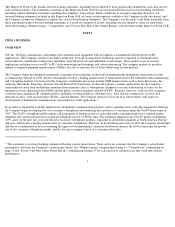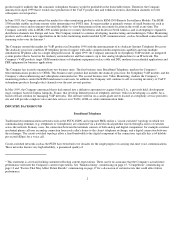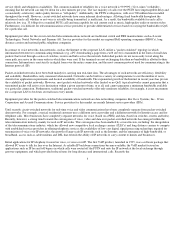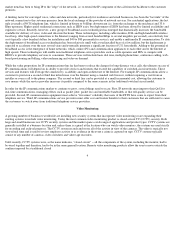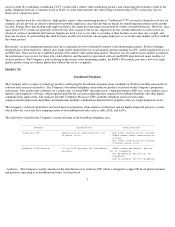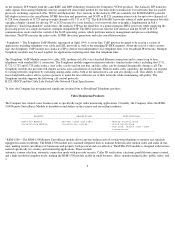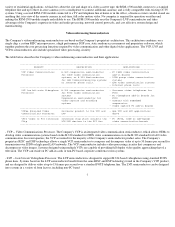8x8 1999 Annual Report Download - page 15
Download and view the complete annual report
Please find page 15 of the 1999 8x8 annual report below. You can navigate through the pages in the report by either clicking on the pages listed below, or by using the keyword search tool below to find specific information within the annual report.access to stored RISC instruction and data and to external dynamic random access memory (DRAM) for access to stored audio, video and/or
graphics data.
Embedded Software
The Company has developed a broad range of application software that runs on the Company's semiconductor products. The Company's
application software allows the use of its semiconductors in systems that conform with various emerging and established international digital
video, audio, graphics and communication protocol telephony standards. By refining its software, the Company can enhance quality, address
new standards and add significant features and functionality to systems that contain the semiconductor product. In addition, certain of the
Company's customers have licensed source code to which they add proprietary features, custom interfaces and, in some cases, algorithm
improvements.
The Company's software can be categorized as follows:
- Control protocols that run on the RISC and manage user control, call negotiation, call progress and mixing and separation of audio, video and
other data.
- Audio and video codec routines that run on the DSP.
- Digital communication and network protocols that interface to external communications networks such as POTS, ISDN and Ethernet LAN.
-
Development tools such as compilers, assemblers and debuggers that allow the Company and customers to write new applications and modify
existing applications.
Algorithm Expertise
The Company has devoted significant resources to develop audio and video codec algorithms to meet new, emerging and established
international telephony and video transmission standards. While most of these standards clearly specify the syntax requirements of a standards-
compliant decoder, and thus what constitutes a valid encoded bitstream, they do not specify the methods by which an encoder generates such a
bitstream. The flexibility of the Company's multimedia communication semiconductor architecture allows the Company to apply its core
algorithm expertise to develop products for a variety of digital and multimedia communication applications.
The Company's algorithm expertise enables the following:
- Parallel Audio Coding and Processing Applications. The Company's proprietary implementations of standards-based audio compression
algorithms and support applications (such as acoustic echo cancellation, tone detection and signal generation) allow systems that contain the
Company's semiconductors to run several channels of IP telephony in parallel on a single device.
- Video Coding Efficiency and Video Quality. The Company's proprietary motion search, mode decision and rate buffer control algorithms
enhance video quality for Video Monitoring and communication applications.
- Integrated Control of Real-Time Systems. Digital and multimedia communication systems are inherently complex due to the convergence of
video, audio, network and control information. The Company's proprietary semiconductor architecture and control software manage these
varying data streams in concert, thereby reducing the complexity of the external system design. In addition, the Company's single-chip control
of audio and/or video data in certain applications provides for audio/video synchronization and minimization of transmission latency.
- Robustness to Varying Network Conditions. Digital and multimedia communication systems must interface to networks with transmission
characteristics that vary over time. These characteristics can cause network bandwidth to change and can result in the loss or corruption of
transmitted information. The Company has developed control algorithms that adapt to changes in network bandwidth and that recover or
conceal the loss or corruption of data in a way that reduces negative perceptual effects on the user.
11


